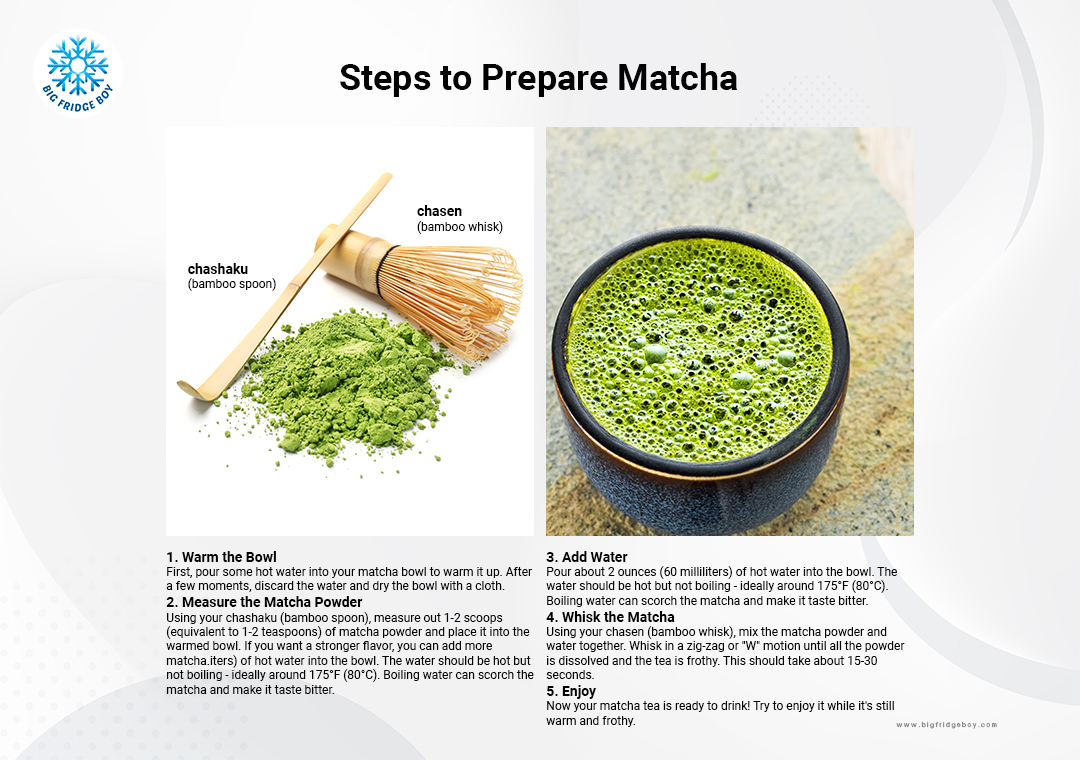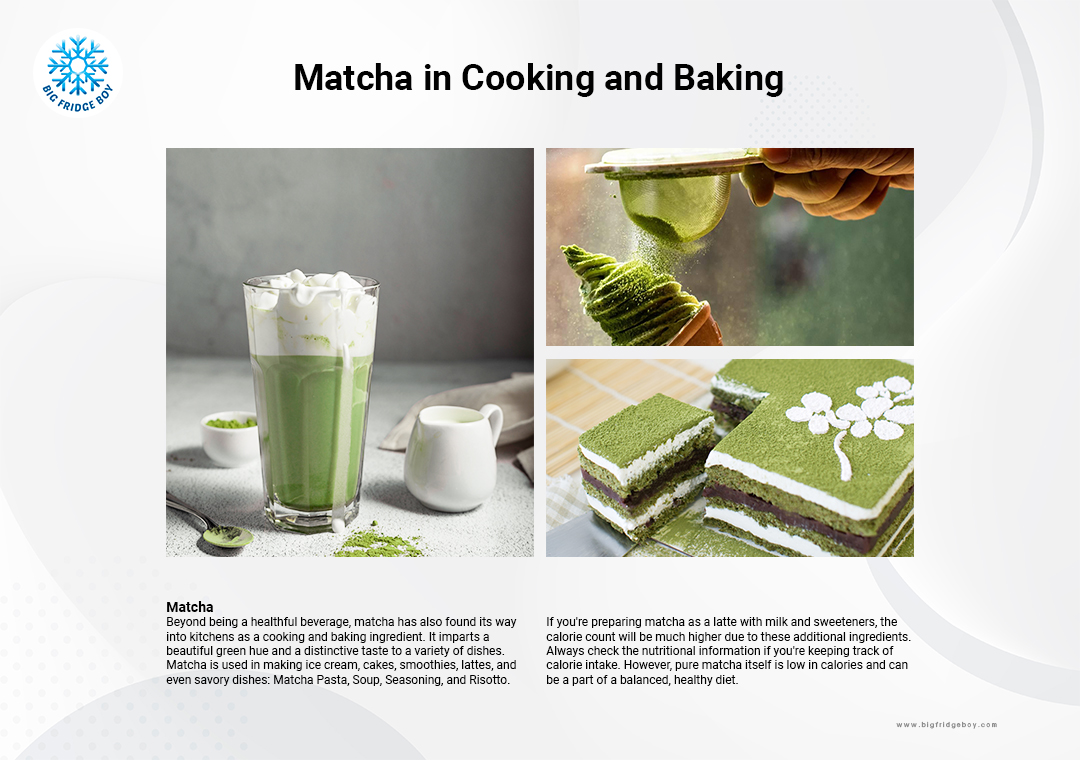"MATCHA: A Sip of Wellness"
Last updated: 6 Jun 2023 | 68912 Views |

What is Matcha?
Matcha is a special type of powdered green tea that is grown and produced in Japan. It has been a key part of traditional Japanese tea ceremonies for centuries and has gained considerable popularity worldwide for its unique taste and health benefits. The term "matcha" itself translates to "powdered tea."
"抹" is pronounced "ma," and it means "to rub" or "to grind".
"茶" is pronounced "cha," and it means "tea".
So, combined, "抹茶" essentially means "ground tea" or "powdered tea", which is what matcha is - finely ground powder of specially grown and processed green tea leaves.
History
The origins of matcha date back to China during the Tang Dynasty (618-907 AD). The Chinese would steam tea leaves and form them into bricks for easy transport and trade. These tea bricks were then ground into a powder and mixed with hot water. This form of tea consumption spread to Japan by a Buddhist monk named Eisai in the late 12th century, where it was used in religious rituals in Buddhist monasteries.
However, it was in Japan that the cultivation and consumption of powdered tea truly flourished, eventually evolving into the unique form known as matcha. The Japanese began to grow tea plants in shade to increase the leaves' chlorophyll content, which gave the resultant powder a vibrant green color and a unique flavor profile. This method of cultivation also boosted the levels of certain nutrients in the tea, including L-Theanine and caffeine.
In the 16th century, a tea master named Sen no Rikyu established the ceremonial way to prepare and serve matcha, which has been passed down through generations and is still followed today. He also played a crucial role in popularizing matcha among the Japanese samurai class, helping to solidify matcha's status in Japanese culture.
Over time, matcha became an integral part of Japanese culture and tradition, particularly through the tea ceremony, known as "Chanoyu" or "the way of tea". This ceremony is a symbol of harmony, respect, purity, and tranquility.
Although matcha fell out of popularity in China in favor of loose-leaf tea brewing, it remained a vital part of Japanese culture and started to gain considerable popularity worldwide in the 21st century. Today, matcha is appreciated not just for its unique taste and health benefits, but also for its deep cultural and historical significance.
How is Matcha Produced?
The production of matcha is a delicate process that contributes significantly to its unique properties. A few weeks before harvest, tea plants meant for matcha are shaded to prevent direct sunlight. This process increases the chlorophyll content, giving the leaves a vibrant green color and boosting their amino acid content, particularly L-Theanine, which is believed to have calming effects.
After the leaves are harvested, they're steamed to halt fermentation, then air-dried. The dried leaves, known as “Tencha”, are then ground into a fine powder using stone mills. This fine powder is the matcha that is used in tea ceremonies and cooking.
Tasting and Enjoying Matcha
Matcha is known for its unique, complex taste that is rich, vegetal, and slightly sweet. It can also have bitter notes, especially if it's a lower-quality matcha or if it's prepared with water that's too hot.

Steps to Prepare Matcha
Remember, preparing matcha is a calming ritual. Take your time, be mindful, and enjoy the process. The result is a beautiful, vibrant, and healthful drink.
- Warm the Bowl
First, pour some hot water into your matcha bowl to warm it up. After a few moments, discard the water and dry the bowl with a cloth. - Measure the Matcha Powder
Using your chashaku (bamboo spoon), measure out 1-2 scoops (equivalent to 1-2 teaspoons) of matcha powder and place it into the warmed bowl. If you want a stronger flavor, you can add more matcha. - Add Water
Pour about 2 ounces (60 milliliters) of hot water into the bowl. The water should be hot but not boiling - ideally around 175°F (80°C). Boiling water can scorch the matcha and make it taste bitter. - Whisk the Matcha
Using your chasen (bamboo whisk), mix the matcha powder and water together. Whisk in a zig-zag or "W" motion until all the powder is dissolved and the tea is frothy. This should take about 15-30 seconds. - Enjoy
Now your matcha tea is ready to drink! Try to enjoy it while it's still warm and frothy.
Health Benefits of Matcha
Pure matcha itself is low in calories and can be a part of a balanced, healthy diet. Drinking matcha every day can be a beneficial habit for several reasons, particularly in the areas of physical health, mental wellness, and daily performance.
- Rich in Antioxidants
Matcha is packed with antioxidants, specifically catechins, which are natural compounds that help prevent cell damage and provide other health benefits. The high concentration of antioxidants in matcha helps the body fend off damage from harmful free radicals, potentially reducing the risk of chronic diseases like heart disease and cancer. - Supports Mental Clarity and Calmness
Matcha contains the amino acid L-Theanine, which is known to boost alpha waves in the brain, inducing relaxation without drowsiness. This can help to reduce stress and anxiety. L-Theanine also boosts concentration and cognitive performance, making matcha a beneficial drink to start the day or to help maintain focus throughout the day. - Promotes Heart Health
Regular consumption of matcha can support heart health due to its cholesterol-lowering effects. The antioxidants in matcha can help prevent LDL cholesterol (the "bad" cholesterol) oxidation, which is a risk factor for heart disease. - Energy Boost Without the Crash
Matcha provides a gentle energy lift due to its unique combination of natural caffeine and L-Theanine. This can lead to improved endurance and increased alertness. Unlike coffee, which can cause jitters and energy crashes, the caffeine in matcha is released slowly, providing sustained energy levels. - Aids in Weight Management
Studies suggest that the catechins in matcha can boost metabolism and increase fat burning, which can support weight loss goals. Matcha can be a great addition to a balanced diet and an active lifestyle. - Detoxifies the Body
Chlorophyll in matcha (which gives it its vibrant green color), drinking this tea regularly can help naturally detoxify the body, removing harmful toxins and heavy metals from the system and also boosts liver function. - Boosts Immune System
The combination of antioxidants, L-Theanine, EGCG (Epigallocatechin Gallate), and various vitamins present in matcha work together to strengthen the immune system, helping you fend off illnesses and recover faster.

Matcha in Cooking and Baking
Beyond being a healthful beverage, matcha has also found its way into kitchens as a cooking and baking ingredient. It imparts a beautiful green hue and a distinctive taste to a variety of dishes. Matcha is used in making ice cream, cakes, smoothies, lattes, and even savory dishes: Matcha Pasta, Soup, Seasoning, and Risotto.
Storing Matcha
Storing matcha correctly is important to maintain its flavor, color, and nutritional properties. Here are some tips for properly storing your matcha
- Airtight Container
Make sure to store matcha in an airtight container to protect it from exposure to oxygen. Exposure to air can degrade the quality of the matcha over time, causing it to lose its vibrant green color and distinct flavor. - Cool, Dark Place
Store your matcha in a cool 59-68°F(15-20°C), dark place. A kitchen cupboard that's away from any heat source is a good choice. Light and heat can both degrade the quality of matcha. - Refrigeration
If you don't plan to use the matcha within a few weeks of opening, consider storing it in the refrigerator at 34-39°F (1-4°C). The cold temperature can help preserve the matcha's quality. However, be sure the container is truly airtight before refrigerating, as the matcha could absorb odors from other foods. When you take it out of the fridge, let it come to room temperature before opening the container to avoid condensation forming inside. - Consume Promptly
Once you've opened your matcha, try to use it up within a few weeks. Matcha is sensitive to air, light, and heat, so even under ideal conditions, it's best to consume it as quickly as possible for the freshest taste. - Avoid Freezing
Unlike some other teas, it's not recommended to freeze matcha as the freezing/thawing process can lead to condensation which degrades the quality of the tea.
Remember, matcha is a delicate tea that requires a bit more care in storage than other types of tea. By following these guidelines, you can ensure your matcha remains as fresh and flavorful as possible.
Matcha, with its unique taste, health benefits, and versatility in the kitchen, is a truly remarkable type of tea. Whether you're a long-time tea enthusiast or new to the world of tea, matcha offers a distinct experience that is well worth trying.






